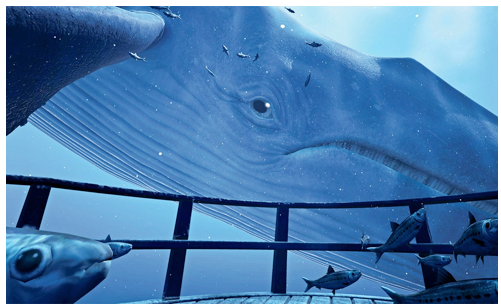CommentsGELFAND’S WORLD--I was standing on the bow of a sunken tug boat, looking up towards the surface about 100 feet above me, with manta rays swimming near the surface but sometimes coming closer. It seemed real, with the sort of detached feeling you get from being under the ocean. Mind you, that aura is something you get for real on scuba, but this time it was in virtual reality (VR) as demonstrated to me by Steven Xu of Vive.com.
He helped me into a sort of half-helmet which contained a full visual display and had ear flaps that reduced the sounds coming from the room. As I turned left to look away from the boat that I was standing on (at least virtually), a giant humpback whale swam slowly by from a distance of a dozen feet or so. Up close in full 3D, it was an amazing sight.
Virtual reality was the subject of a panel and demonstration over the second weekend of the San Pedro International Film Festival (SPIFF). It's where I saw the whale and heard a group of experts consider the future of the technology.
Saturday's experience was a bit unnerving because of the whale, perhaps because -- as a scuba diver -- I avoided anything larger than a sea lion in the real ocean. But even absent our leviathan, it was exciting and educational in a way that standard film and television cannot match.
How to explain the difference? In the good old days, filmmakers experimented with ways to present a three dimensional image to the audience. Back then, many of us saw one or two 3D films using those infamous cardboard glasses that had red cellophane covering one eye and blue cellophane covering the other. What was projected on the screen was likewise separated into color-coded left and right images. It was a long way from perfection, but you got some 3D effect. More recently, the use of polarizing filters in the glasses gave us 3D in full motion with pretty good color rendition. In either case, we used glasses which passively filtered what was happening on the screen.
At that level, 3D had the characteristic that whether you turned your head or held still, the image remained in the same place on the screen. It didn't expand in either direction if you looked left or right.
VR is different. I was looking at the sunken tugboat without being aware that there was a whale in the image-space to my left. It was only when I turned to look left that I discovered the whale's existence. There is a lot more information to discover and experience, which also means that each VR session is different from the previous one, even if you are watching the same program.
In VR, you have goggles or a helmet which actively presents the image to each eye separately, using the equivalent of a mini-computer screen on each side. In addition, the VR system uses positional sensors to calculate where you are looking, from which it figures out what part of its entire image-space to present to you.
In other words, with VR you can look around. It's a more compelling experience of whatever world is being presented to you.
At the panel discussion, what I heard involved both hope for the future and concerns about the hurdles to VR's wide scale adoption.
One issue, as one panelist quaintly stated, was that the entertainment industry hasn't figured out how to monetize the new technology adequately. More simply put, VR isn't the same experience as taking your date to the movie theater and holding hands while eating popcorn out of the same carton. Being encased in a helmet is a more solitary experience. The social part of movie going would be lost. Hissing the bad guy and rooting for the hero is going to be a lot harder to do in a helmet. That means that it would be a lot harder to sell tickets to the younger demographic.
That statement about hissing the bad guy raises another point that was introduced by one of the panelists. As she stated, VR presents experience (the little fishes and the giant whale) as opposed to a storyline (the good guy battling the bad guy).
Might I suggest through a historical analogy that this situation isn't likely to be permanent? At the beginning of cinema (around 1895 and for a few years), movies showed you real things -- people walking out of factories, or Queen Victoria reviewing a military parade. This was the cinema of objects and direct experience. The coming of movies with stories is referred to as the introduction of narrative cinema. By the year 1903 or so, narrative cinema was in full fling.
I suspect that turning VR into full length feature films is going to be a lot harder to do technically than what happened between 1895 and 1903. Why this is so would require a long treatise. Trust me on this one -- it's going to be a lot more complicated. But we already have some of what it will take, albeit in expensive, experimental versions. Eventually VR will get there if inventors and investors want it.
So is VR the future of entertainment? In its favor, it is incredibly more realistic as an experience of the environment -- real or concocted -- whether it is under water, in space, or in the middle of your city.
I suspect that if VR is to become a stunningly successful entertainment technology, it will have to involve that process of marrying the VR experience to the narrative storyline. This might involve something as predictable as creating the vastness of the VR space (the tugboat, the ocean) in a computer simulation and adding human actors into the mix.
Now take it one step further. Imagine a system in which the VR image is combined with your immediate surroundings. You could still have date night, but you and your companion would be at the bottom of the Grand Canyon or next to me on that sunken tugboat.
There are several such systems in development. The question is when it will be possible to present such experiences to lots of people using goggles or helmets that can be built for $300. (OK, if the new iPhone is nearly a thousand dollars, then how about an Augmented Reality device for the same price?)
The creation of full length fiction in VR provides an answer to the problem of making money off the new technology. The creation of an income stream is what it will take to generate a new generation of entertainments that bring you, the viewer into a more complete and realistic-seeming world. When you look to the left, you won't just see your date's popcorn carton, but also the whale's tail.
Meanwhile, VR offers us an enormous number of other possible applications. During the Q and A, I asked about using VR to help the next generation of students through such traditionally difficult subjects as chemistry and molecular biology. It turns out that there are a few groups working on these challenges, generally at large research universities. This would be a good industry to develop here in Los Angeles, considering that we are pushing the idea of Silicon Beach (Mayor Garcetti, are you reading this?).
Teenagers staffing ambulance crews and other interesting films
High School 9-1-1 is a documentary film about an ambulance post serving Darien, Connecticut. For more than a decade, this post has been staffed by teenagers from the local high school. They are fully trained and take on the considerable responsibility of dealing with a man in cardiac arrest, a drunk, and ordinary crashes on the local interstate. The film shows us the teenage ambulance crew arriving on the scene of the cardiac arrest and (spoiler alert) later shows the survivor, a television sports reporter, who congratulates the students for saving his life. In conversation, the filmmakers explained that in the Darien region, the police used to work the ambulances when there was a medical emergency. This lowered the police presence by half when the cops had to leave their patrol cars to tend to the sick and injured. A local man pushed the idea of bringing in local students to drive the ambulances and tend to patients. The system seems to be working well, but has not spread to other places.
The Darien Post 53 experience offers L.A. a model for teaching how to deal with injuries that might occur in the event of a major earthquake. There are obvious differences (most of us don't have a defibrillator handy) but there may be enough similarities to warrant taking a look. Congratulations to Tim Warren and his colleagues for an intriguing film.
Knights of Rock is a series that tells the inside stories of the golden age of rock. On Sunday, Oct 15, San Pedro local and onetime Fleetwood Mac tour organizer Leo Rossi introduced his series to the Spiff festival. Men who worked on the Fleetwood Mac tours told tales about how they lived, and how they learned ways to make a performance happen effectively. As Rossi explained, they developed techniques and equipment that revolutionized the whole rock tour system. As they explained further, they aren't interested in talking about the (by now dull) subjects of sex and drugs. They did talk about how hard they worked, how they would often wake up in a motel (after a while, every motel room looked the same) and look for the phone book just to find out where they were that morning. One explained that for them, the day only started when they were onsite setting up for the performance, and that was what they lived for.
Order's Up is that scarcity, a short piece about a restaurant (and the cranky characters who run it) that is actually funny. The chef is a bit over-controlled for what is going on around him, and thereby manages to play against the television cliche of the screamer and bully. He is quite the opposite -- and thereby gets laughs. The visual gags are also fun, particularly as regards a couple who get huge portions served up when the restaurant had mistakenly expected a party of twenty and only got two. The film was written by Natasha Sattler, an upcoming talent with a partial connection to San Pedro, where this film was shot.
(Bob Gelfand writes on science, culture, and politics for CityWatch. He can be reached at [email protected])
-cw











